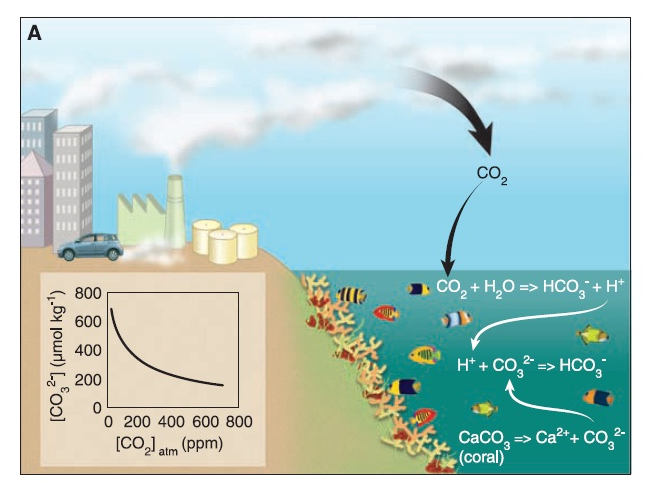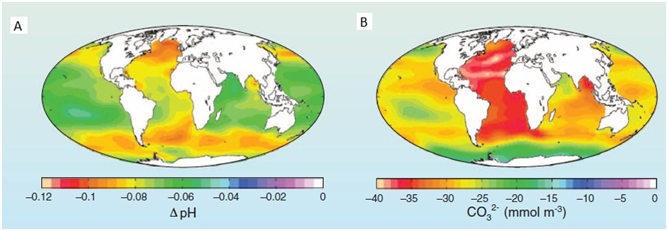Being a marine biologist by training, I find the connection between the ocean and climate systems most interesting. The oceans play a critical role in our climate system. Unfortunately our oceans are not immune to climate change and are significantly affected by it. It has been documented and observed that alterations of the environment are already being observed with profound consequences. Such changes include sea-level rise, changes in ocean productivity and resource availability, increased storm intensity, loss of sea ice, disruptive seasonal weather patterns, altered supply and quality of freshwater and ocean acidification.
Our understanding of the effect of climate change on the marine ecosystem is significantly lagging behind that of the terrestrial environment. According to Hoegh-Guldberg & Bruno (2010), this is largely due to the size and complexity of the ocean and the relative difficulty of taking measurements in the marine environment. Therefore, long term studies of climate change in the oceans are rare and need additional attention.
The oceans do not only act as the planet heat sink, but they also absorb approximately one-third of the carbon dioxide (CO2) produced by human activities (Hoegh-Guldberg & Bruno, 2010). While absorption of CO2 by the ocean slows the atmospheric greenhouse effect, it puts marine and thus human life at risk. CO2 reacts with water to produce carbonic acid, which releases protons that combines with carbonate ion. This in turn decreases the concentration of carbonate, making it unavailable to marine calcifiers such as corals (Hoegh-Guldberg et al. 2007) (See Figure 1 below).
The ocean’s surface layer has acidified as a consequence of the absorption of anthropogenic CO2, with a steady decrease of 0.02 pH units per decade over the past 30 years and an overall decrease of 0.1 pH units since the pre-industrial period, having a large impact on the concentration of carbonate ions (Hoegh-Guldberg & Bruno, 2010) (See Figure 2 below).

Figure 1: Linkages between the buildup of atmospheric CO2 and the slowing of coral calcification due to ocean acidification (Hoegh-Guldberg et al. 2007).

Figure 2: (A) Estimated change in annual mean sea surface pH between the pre-industrial period (1700s) and the present day (1990s). (B) Estimated change in annual mean sea surface carbonate ion concentration between the pre-industrial period (1700s) and the present day (1990s). [Credits: Global Ocean Data Analysis Project (57)] (Hoegh-Guldberg & Bruno, 2010).
Although these physical changes may seem small the consequences are not, and the impacts on marine biodiversity and ecosystems are less clear. The marine chemistry would be substantially altered and the subsequent extinction events not seen for 65 million years would likely occur if the atmospheric CO2 concentration doubled (McLeodet al. 2008). Such a doubling could occur in the next 50 years. Consequence of ocean acidification are numerous including; coral reefs no longer being sustainable (Hoegh-Guldberg et al. 2007, Hoegh-Guldberg et al. 2009); a change in the distribution, abundance, phenology and productivity of phytoplankton communities (Hoegh-Guldberg & Bruno, 2010); large areas of polar waters becoming corrosive to shells of some key marine species (McNeil & Matear, 2008); and a reduction in shellfish production, therefore impacting the aquaculture industry (Zeebe et al. 2008). Marine ecosystems are expected to look nearly unrecognizable (Orr et al. 2009).
With this continuous absorption of CO2, the oceans ability to buffer changes to the atmosphere decreases and also minimizes that amount of CO2 it can update. This inability to act as the earth’s largest carbon sink creates little buffering for the atmosphere, terrestrial and human ecosystems; increasing vulnerability.
The oceans have an overwhelming importance to life on our planet, therefore it is vitally important that there are changes made to limit atmospheric greenhouse gases and reduce the affect these have on the oceans and therefore all life on earth.
References
Hoegh-Guldberg, O.; Mumby, P. J.; Hooten, A. J.; Steneck, R. S.; Greenfield, P.; Gomez, R.; Harvell, C. D.; Sale, P. F.; Edwards, A.J.; Caldeira, K.; Knowlton, N.; Eakin, C. M.; Iglesias-Prieto, R.; Muthiga, N.; Bradbury, R. H.; Dubai, A. & Hatziolos, M. E. 2007.Coral Reefs Under Rapid Climate Change and Ocean Acidification. Science 318(5857): 1737-1742.
Hoegh-Guldberg, O. et al. 2009. The Coral Triangle and Climate Change: Ecosystems, People and Societies at Risk. WWF Australia, Brisbane, 276pp.
Hoegh-Guldberg, O. & Bruno, J. F. 2010. The Impact of Climate Change on the World’s Marine Ecosystems. Science Vol 328: 1523-1528.
McLeod, E. et al. 2008. The Honolulu Declaration on Ocean Acidification and Reef Management. The Nature Conservancy, U.S.A., and IUCN, Gland, Switzerland.
McNeil, B.I. & Matear, R.J. 2008. Southern Ocean acidification: A tipping point at 450-ppm atmospheric CO2. PNAS 105(48): 18860-18864.
Orr, J.C. et al. 2009. Research Priorities for Ocean Acidification, report from the Second Symposium on the Ocean in a High-CO2 World, Monaco, October 6-9, 2008, convened by SCOR, UNESCO-IOC, IAEA, and IGBP, 25pp.
Zeebe, R. E.; Zachos, J.C.; Caldeira, K. & Tyrrell, T. 2008. Carbon Emissions and Acidification. Science 321: 51-52.